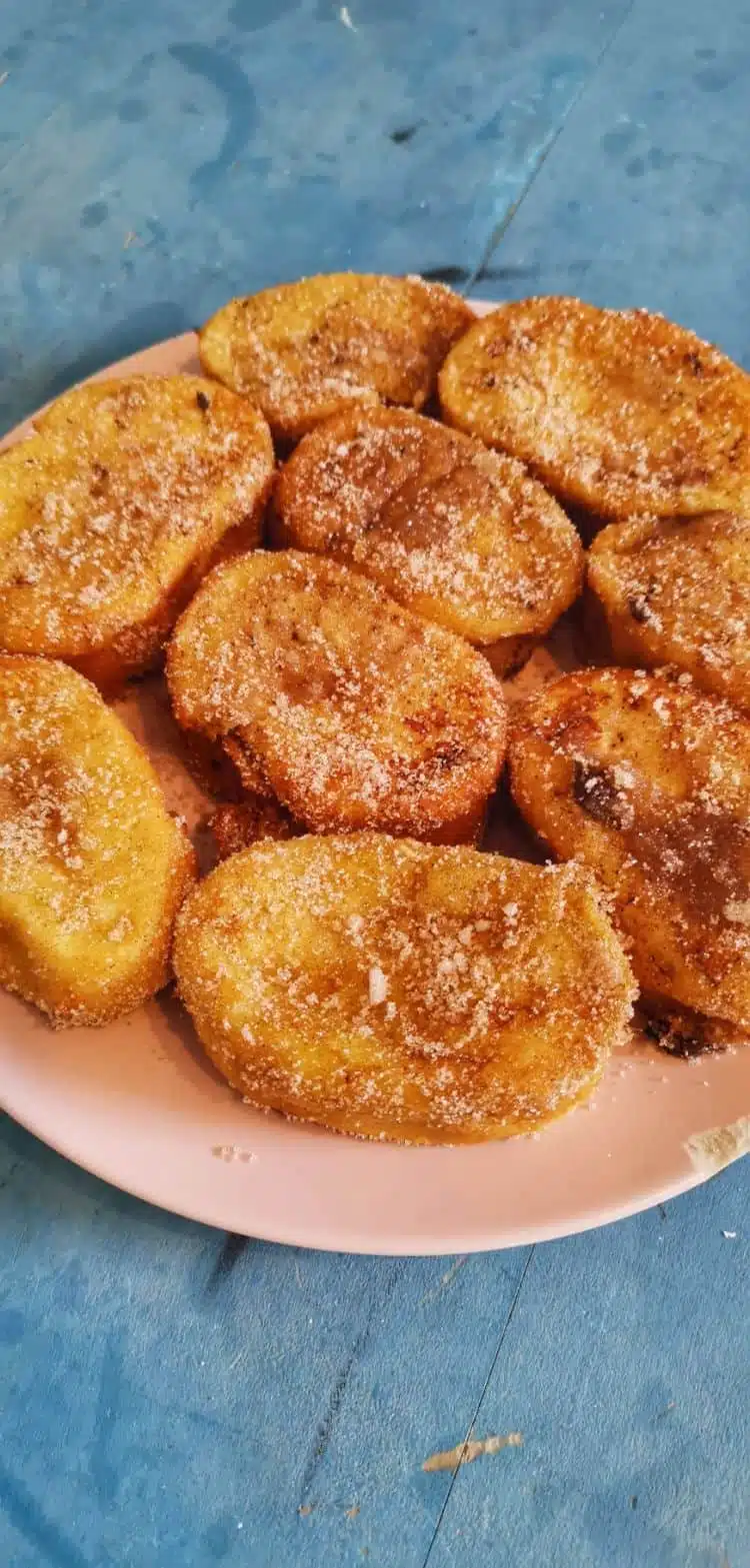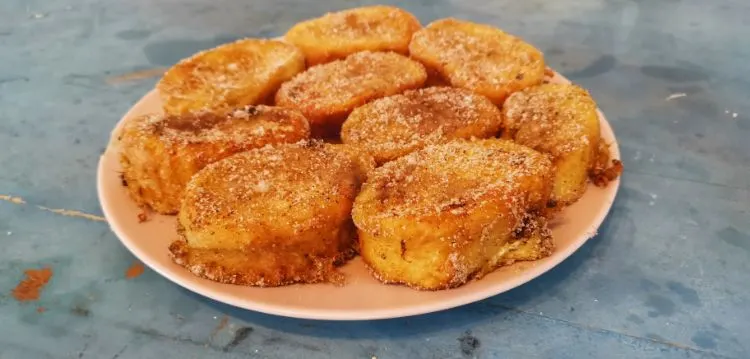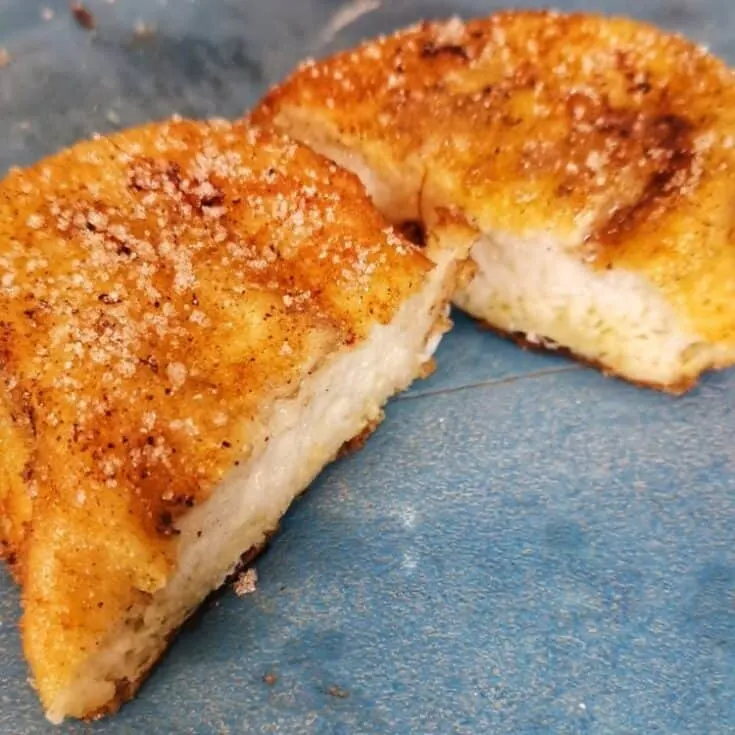Torrijas have long been part of Spanish cuisine. Know how to make this decadent delight with our easy-to-follow Spanish Torrijas recipe.
Torrijas are a classic Spanish dessert that has long been part of Spanish cuisine, with the traditional way of cooking being passed on from one generation to the next.
While traditionally eaten on specific religious celebrations, these sweet delights have found their way into breakfast tables and regular menus.
This sweet dessert is the perfect thing to bring to a brunch. This version is simple but delicious and will make your family smile.
The crust is the perfect crunchy but bendable contrast to the custardy bread pudding middle. The smell of this dessert baking in your kitchen will fill the house with happy holiday scents that will keep your family coming back for seconds!
Warm and flaky, you won’t find them difficult to prepare, but you will find that they are delicious! Torrijas can easily be your new favorite comfort food!
This classic torrijas recipe with step-by-step instructions will show you how to create an unforgettable Spanish dessert your friends and family will love!
Want to get to know more about this delectable dish? Keep on reading to learn how we make them around here!
What does torrijas mean?
Torrijas are Spanish-style toasts. They are also regarded as rebanadas de Carnaval (Carnival slices), tostadas (toasts) or tortillas de leche (milk tortillas.)
Others just incautiously call them Spanish French toasts or describe them as fried bread pudding. And that is a pretty accurate description- you could think of them as the cross between French toast and bread pudding!

What are torrijas made of?
Traditionally, torrijas are made of a slice of stale bread soaked in milk flavored with vanilla, cinnamon, and the like. It is then re-soaked in a bowl of beaten eggs batter before being fried in olive oil until it is crispy and golden, then drenched with a sweet syrup that soaks into the crispiness.
Simply put, it is basically fried bread served with a topping of choice, but generally sprinkled with a generous dusting of cinnamon sugar.
Most Spanish torrijas recipes begin with the same basic instructions although there are as many different methods of preparing torrijas as there are people who make them.
In Seville, for example, most of the versions that you can try will usually be thick and sweet, slightly eggy, covered in honey, and always served cold. They are a delicious treat you could enjoy with your afternoon coffee.
However, in Madrid, you might come across different torrijas recipes each Easter season, one made with a bit of sweet red wine and another covered with milk and cinnamon. Both are delicious and worth trying!
Different substitutions can be used to make it your own, but this traditional Spanish way is a keeper!
This recipe makes many servings, but the torrijas are easy to freeze for future use. You can buy most of the ingredients at your local grocery store, so you’ll have this delicious torrijas recipe ready when visitors come for holidays like Christmas or Thanksgiving!
Or eat it all yourself if you’d rather!
Where did torrijas originate?
Torrijas originated in Spain. It has been a staple Easter dish eaten by religious people fasting on meat during the Holy Week in observance of Lenten traditions.
It is quite filling because of the bread and energizing because of its sweetness, thus giving people a pleasant boost.
A deeper digging through the archives will reveal that torrijas have been around Spain’s gastronomic entity since the 15th century.
It has been known to be prepared for pregnant mothers who were about to give birth.
People believed that the nutritional contents of torrijas gave much-needed strength to the mothers.
On a more general note, torrijas were popular in Andalucian convents because it was an efficient way for them to use their old slices of bread.
An old Roman dessert called aliter Dulcia is very similar to the torrijas of today.

Torrijas vs French Toast
While torrijas and French toast share about the same ingredients, there is a major difference in the way it is cooked.
Torrijas are fried in olive oil, given the abundance of the said cooking material in Spain. French toast, on the other hand, is fried in butter.
Furthermore, torrijas are soaked in flavored milk and then dipped in beaten egg. In making French toast, egg and milk are commonly combined.
The finished products, though, look strikingly similar to each other.
Torrijas Ingredients
As you already know, making this dessert is easy and it tastes amazing. This torrijas recipe is made with inexpensive ingredients, similar to making french toast, and requires very little work.
It is useful however to take these notes before gathering your ingredients to make the most delicious batch!
When making Spanish torrijas, bread plays a crucial role. If you want to make it like Spaniards, and can’t get your hands on Spanish bread, I recommend you use French bread. Alternatively, you can also use challah, brioche, or baguette bread.
What’s important is to remember that they are traditionally made with day-old bread. Be sure to let the bread dry out for a while on the counter before slicing it into thick slices.
Moving on to the dipping! Depending on where you live in Spain or your personal preference, you can prepare torrijas in different ways. They can be:
- Torrijas de Leche: To make Torrijas de leche dip the bread in milk (with a touch of vanilla), then roll in the bowl of beaten eggs and fry them.
- Torrijas de Vino: Instead of milk, the bread is also dipped in sweet red wine. This is a particularly popular treat during Semana Santa. I’ve also seen liquor dipped torrijas, so if you like to experiment I recommend you try out this one!
Last but not least, if you want to add texture to the torrijas, coat them with cinnamon sugar instead of sugar. Over the torrijas, stir and sprinkle 1/4 cup granulated sugar and 1/8 teaspoon ground cinnamon.
And now, let’s get to cooking!
Step-by-step Spanish Torrijas Recipe
1. To begin, use day-old bread that is slightly stale.
2. Mix milk and vanilla. Pour the warm milk and vanilla into a shallow bowl.
3. Next up, soak the slices! Dip a slice of bread in the milk on both sides, letting it soak in for several seconds.
4. Crack the eggs into another shallow bowl and beat them well until smooth. Next, batter the slices in the beaten eggs.
5. Pour olive oil in a pan- it is best to pan-fry the torrijas!
6. Cook in the pan for several minutes, flipping and frying both sides until they become golden brown.
7. Torrijas should be rested on paper towels after frying to absorb excess oil.
Tips for great torrijas
- The staler the bread the better, even though more and more people right now are using fresh bread. A stale bread will absorb more liquid.
- If there is no stale bread in your kitchen and you still would like to make torrijas, you can toast your bread quickly so that it turns dry.
- Should you wish to reheat your torrijas, avoid placing it in a microwave. Instead, place it on a pan over low heat or put it in an oven toaster on low heat as well.
- Take it up a notch and replace milk with either red or white wine!
- Make your own fruit syrup to drizzle over the top of the torrijas just before serving.
- Torrijas are best hot from the fryer when they’re crisp on the outside and soft and custardy inside, but they’re great warm from the fridge or at room temperature, too – the texture just changes slightly. Wrapped in a plastic bag, they can be kept in the refrigerator for up to five days or in the freezer for up to a month. To reheat them, simply pop them in an oven set to 350°F for 10 to 15 minutes.
Torrijas Serving Suggestions
Torrijas might or might not be considered a Spanish version of French toast, but it’s not important—these are a delicious snack or dessert either way!
They can be served warm or cold and are often served as desserts, but could also be served for brunch. It all depends on how you decide to serve them!
Not sure what topping suits them best? Check out what I’ve got to share!
The Torrija is usually covered with cinnamon and sugar, though sometimes sweet syrup is used, such as honey or simple syrup. Pour flavored honey, such as orange blossom, clover, or eucalyptus, over the bread before serving for an extra kick to the taste.
There are even some that are dipped or drizzled in chocolate (not traditional, but delicious).
They can also be topped with dulce de leche (caramel), nata (creme fraiche), queso de cabra (goat cheese), fresh fruits, honey, and honestly any sweet treat you would like to combine!
Serve torrijas with cafe con Leche, coffee or sprinkle them with powdered sugar to enjoy with tea as well!
Sweet, gooey, crunchy, and delicious – the possibilities are endless!
Spanish Tapas Recipes
If you like Spanish Tapas, you should have a look at these easy recipes:
1. Ensalada Russa (Spanish Potato Salad) – Ensalada Rusa is popular in many countries and is also well-known as Russian Potato Salad or Oliver Salad.
2. Delicious berenjenas fritas con Miel (Spanish crispy fried eggplant with honey) – The honey gives the dish a sweet taste and makes it a great starter or tapas.
3. Chorizo al vino Tinto (Chorizo in Red Wine Sauce) – Spain is famous for its chorizos, so it is no wonder that there are many different recipes on how to prepare chorizo.
4. Tinto de Verano (Spanish Summer Wine) – The translation (Spanish Summer Wine) best encapsulates this Spanish drink: a thirst-quenching alcoholic beverage perfect for drinking on a hot summer day.
Let me know in the comments how you liked the recipe and tag @spanishfoodguide when you share a photo on Instagram!
Spanish Torrijas Recipe

Torrijas have long been part of the Spanish cuisine. Know how to make this decadent delight with our easy-to-follow Spanish Torrijas recipe.
Ingredients
- 1-liter milk
- Bread from the previous day
- 3 to 4 eggs
- Extra Virgin Olive Oil
- Lemon and orange peel
- Sugar
- Cinnamon (powder)
- 1 cinnamon stick
Instructions
1. Cut the bread in slices
Cut the bread in slices of around one inch or 2.5 centimeters.
I recommended using bread from the previous day or even bread that is two or three days old. If the bread is hard, it can soak up more milk.
2. Cut off a few small pieces of fresh lemon and orange peel.
3. Let the bread soak in milk
Mix the milk with the cinnamon stick and the orange & lemon peel.
Afterward soak the slices of bread in the milk and let it rest for around four hours.
The longer you soak the bread in the milk the juicier the Torrijas will get.
4. Dip the bread in the egg
After four hours, take the pieces of bread out of the milk and let them drain for a few minutes.
Meanwhile, beat the eggs in a shallow bowl.
In the next step dip the bread slices with both sides one by one in the egg.
5. Deep fry the soaked bread slices
Heat up around 1 inch of olive oil in a pan and carefully transfer the soaked bread slices into the oil.
I recommend using a spatula and a fork as the bread will be very soft and can break easily.
Fry the slices for around two to three minutes on each side until they are brown.
6. Put the bread on a paper towel
Once the bread is done take it out and put it for a few minutes on a paper towel.
7. Dunk the bread in a sugar & cinnamon mixture
Mix sugar and cinnamon on a deep plate and dunk the bread slices into it.
8. Enjoy your home-made Spanish Torrijas!
Nutrition Information:
Yield:
4Serving Size:
1Amount Per Serving: Calories: 267Total Fat: 13gSaturated Fat: 5gTrans Fat: 0gUnsaturated Fat: 7gCholesterol: 207mgSodium: 242mgCarbohydrates: 21gFiber: 1gSugar: 2gProtein: 16g
The nutritional information provided is approximate and can vary depending on several factors, so is not guaranteed to be accurate.
